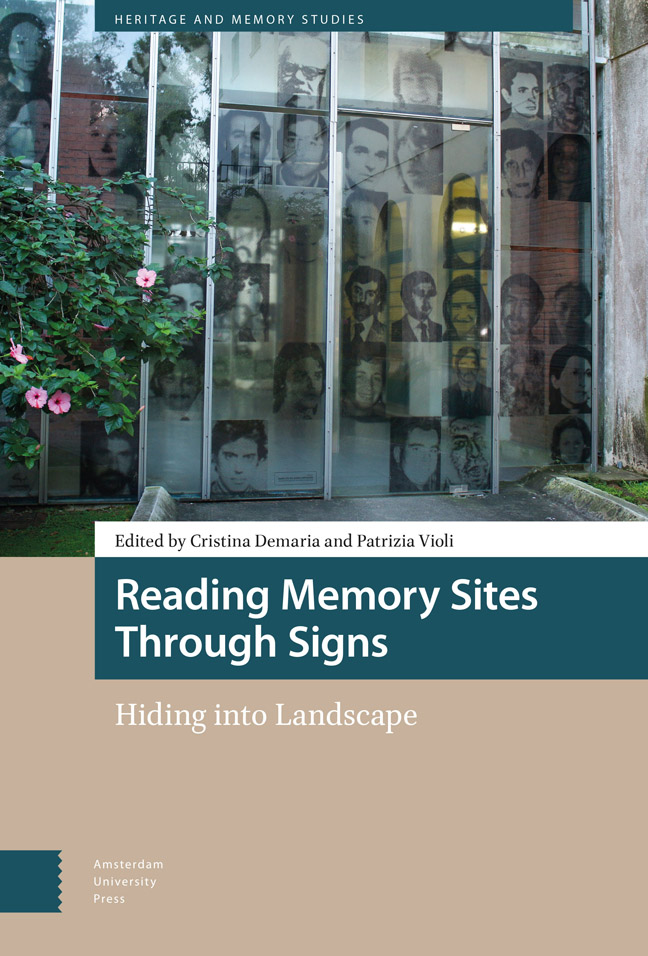Book contents
- Frontmatter
- Contents
- List of Illustrations
- For a Semiotics of Spaces of Memories: Practices of Enunciation and Narratives from Monuments to Global Landscapes of Inheritance
- 1 Stories that Shape Spatialities: Lieu and Milieu de Mémoire through the Lens of Narrativity
- 2 Interpretation and Use of Memory: How Practices Can Change the Meanings of Monuments
- 3 Uncomfortable Memories of Fascist Italy: The Case of Bigio of Brescia
- 4 What Does Fascist Architecture Still Have to Tell Us?: Preservation of Contested Heritage as a Strategy of Re-Enunciation and ‘Voice Remodulation’
- 5 Berlin, the Jewish Museum and the Holocaust Memorial
- 6 Making Space for Memory: Collective Enunciation in the Provincial Memory Archive of Córdoba, Argentina
- 7 Ruins of War: The Green Sea and the Mysterious Island
- 8 Turning Spaces of Memory into Memoryscapes: Cinema as Counter-Monument in Jonathan Perel's El Predio and Tabula Rasa
- 9 Voices from the Past: Memories in a Digital Space: The Case of AppRecuerdos in Santiago, Chile
- 10 500,000 Dirhams in Scandinavia, from Mobile Silver to Land Rent: A Semiotic Analysis
- Index
- Index of Names
3 - Uncomfortable Memories of Fascist Italy: The Case of Bigio of Brescia
Published online by Cambridge University Press: 17 February 2024
- Frontmatter
- Contents
- List of Illustrations
- For a Semiotics of Spaces of Memories: Practices of Enunciation and Narratives from Monuments to Global Landscapes of Inheritance
- 1 Stories that Shape Spatialities: Lieu and Milieu de Mémoire through the Lens of Narrativity
- 2 Interpretation and Use of Memory: How Practices Can Change the Meanings of Monuments
- 3 Uncomfortable Memories of Fascist Italy: The Case of Bigio of Brescia
- 4 What Does Fascist Architecture Still Have to Tell Us?: Preservation of Contested Heritage as a Strategy of Re-Enunciation and ‘Voice Remodulation’
- 5 Berlin, the Jewish Museum and the Holocaust Memorial
- 6 Making Space for Memory: Collective Enunciation in the Provincial Memory Archive of Córdoba, Argentina
- 7 Ruins of War: The Green Sea and the Mysterious Island
- 8 Turning Spaces of Memory into Memoryscapes: Cinema as Counter-Monument in Jonathan Perel's El Predio and Tabula Rasa
- 9 Voices from the Past: Memories in a Digital Space: The Case of AppRecuerdos in Santiago, Chile
- 10 500,000 Dirhams in Scandinavia, from Mobile Silver to Land Rent: A Semiotic Analysis
- Index
- Index of Names
Summary
Abstract
This chapter reflects on an emblematic sculpture of one of the most controversial Italian memories, that of Fascism: the so-called statue of Bigio in Brescia, a symbol of Fascist values. In particular, I examine – within the framework of a critical analysis of ideological discourse – the public reactions and the negotiation of meaning which, after Fascism, involved the legitimacy of the monument, between the desire for cancellation and attempts at historicisation.
Keywords: Controversial Memory; Monuments; Ideological Discourse; Semiotics; Aesthetic Analysis.
The object of this contribution is an Italian monument: a sculpture emblematic of a controversial memory, Fascism. It is a sculpture that has characterised and marked a very significant public space: a square in the centre of Brescia in northern Italy. Due to its urban location and strongly connotative dimension, I consider it a relevant object for a volume on the spaces of memory.
It is the so-called statue of Bigio of Brescia, made in 1932 by Arturo Dazzi, which was removed from Piazza della Vittoria in 1945 and has never since been returned to its place. I will look at the controversial events in greater detail below; it clearly represents a textbook case study on the problem of the legitimacy of monuments that were the expression of a particular regime, in this case Italy's Fascist regime.
There has been a very strong revival of this practice of ‘monumental aggression’ just recently, starting in the summer of 2020, when, following the killing of George Floyd, the Black Lives Matter movement called for the demolition of statues glorifying persons guilty of racism, slave ownership and other dubious acts, setting off an international tendency to de-monumentalise racist and Fascist symbols (so that in Italy, for example, the statue of the journalist Indro Montanelli was attacked, as he was guilty of having married a 12-year-old girl in Ethiopia during the Fascist colonial era, within the framework of the legal practice of the ‘madamate’ at the time).
The case of Bigio in Brescia seems to be a textbook example of the polarisation of a debate between on the one hand the supporters of the cultural legitimacy of Fascist monuments, and on the other those who consider expressions of Fascist propaganda unacceptable.
- Type
- Chapter
- Information
- Reading Memory Sites through SignsHiding into Landscape, pp. 81 - 100Publisher: Amsterdam University PressPrint publication year: 2023

